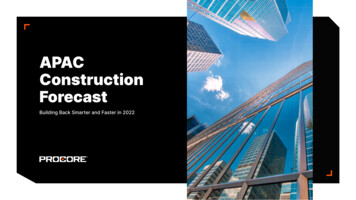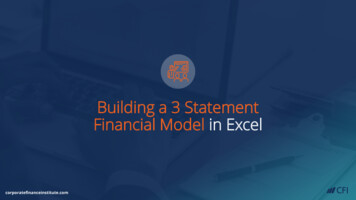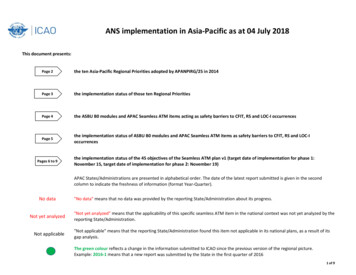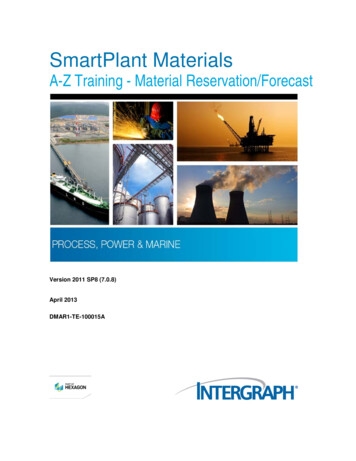
Transcription
APACConstructionForecastBuilding Back Smarter and Faster in 2022
— IN T R ODUC T I ONBuild back better“Optimism for the new year is soaring as regional marketschart their paths towards a post-pandemic future.”- Jones Lang LaSalle (JLL)There is no doubt the last two years have been challenging for almost every countryin the world. In response to the adversity caused by the pandemic, the catchcry ofeconomists and governments has become “build back better”, and for the constructionindustry, the emphasis on “build” is the good news we needed.Financial experts have recognised the role of infrastructure and construction asshots in the arm for national wealth. Evidence of this is seen through the BidenAdministration’s ambitious infrastructure agenda in the US, the EU’s continued focuson the net-zero transition, and, in many Asian nations, the focus on social issues likehousing shortages.At the end of 2021, the rise of the Omicron variant forced economists to hastily amendgrowth projections. However, economic recovery is still believed to be on the cards,albeit slightly slower. The predictions from banks, the OECD, rating agencies andothers project a rebound of around 4.5% global GDP growth for 2022.“While COVID-19 headwinds persist,the virus should progressivelybecome less of a factor in drivingeconomic outcomes with the globaleconomy expected to continueexpanding at an above-average pace.”Ric DeverellMacquarie Group Chief Economist
Contents01 The Big Shifts0402 Top Trends for APAC Construction0703 Australia1104 New Zealand1505 Singapore1806 Philippines2107 Malaysia2308 Hong Kong2509 Conclusion27
01—APAC CONSTRUCTION FORECAST 4C HA P TER ON EThe Big ShiftsWhat started in early 2020 as a rapid pivot todigital solutions and virtual platforms to keepcompanies operating during Covid lockdownshas shaped a new trajectory for the world. Thedigital transition was already a trend, andCovid made it an imperative.Significant challenges still remain, such as ashortage of labour in many countries, mentalhealth impacts of the pandemic, and buildingdigital skills and capacity.Labour ShortagesSafetyLabour shortages are faced worldwide due to multiplefactors. Currently, we see entry restrictions for non-citizenworkers in economies like Australia and the UK, whileSingapore has become reliant on migrant workers. Workershortages have been more noticeable than before. In fact,even the shortage of workers within the supply chain, suchas the truck driver shortage in the UK, has sent shocksthrough broader consumer supply chains.The spotlight on psychological safety has grown, aspeople’s mental health has deteriorated over the last twoyears. RMIT researchers found project-based constructionprofessionals were impacted negatively at the height of thefirst pandemic wave regardless of whether they workedon-site or remotely. Anxiety relating to news coverage,lengthy virtual meetings, working irregular hours tomanage increased correspondence, and overlap betweenwork and family life has increased.Lockdowns have also played a major role. Throughout2020 and 2021, job sites were shut down all around theworld at various times to slow the spread of Covid. Thishas forced some workers to leave the construction industryaltogether due to income insecurity.—“Organizations in the construction industry recognisethe value of making mental health more visible andsharing resources. This serves to educate workers aboutmental health, reduces stigma, and shows organisationalcommitment to worker mental health and well-being.”— Mental Health and Well-being in the ConstructionIndustry 2021 PULSE SURVEY
APAC CONSTRUCTION FORECAST“In 2022, connectedconstruction will likelybe a catch-all for majordigital investments toconnect, integrate, andautomate operationsand bring the entirevalue chain onto asecure, intelligentinfrastructure.”Deloitte 5
APAC CONSTRUCTION FORECASTDigitalThe Zero Carbon ChallengeAccording to Deloitte, labour shortages, supply challenges,price increases and scarcity of materials have contributedto the emphasis on efficiency in 2022. Constructionfirms’ interest in prefabricated and modular constructiontechniques optimisable by digital design and projectmanagement tools has peaked.Since the net-zero commitments made at the COP26Summit in Glasgow in 2021, there is a renewed focus onclimate action. Sustainability is now firmly on the agenda––particularly in Australia, New Zealand, Singapore andMalaysia. Turner and Townsend state this will impact theway projects are designed and delivered.Dodge Data & Analytics surveyed construction firmsglobally to find that those who have adopted BIM forproject design coordination are embracing other digitaland technology-enabled processes, including 3D printing,virtual reality, cloud-based technology for project dataexchanges and safety analysis on site.—“As one of the most significant contributors to carbonemissions, the way that the construction industryconstructs, manages, and operates built assets is acentral focus in the race to reach [Net Zero Carbon],” — Turner and Townsend, ANZ Market Insight Report. 6
02—APAC CONSTRUCTION FORECASTCHA P TER T WOTop Trends for APACConstructionSince the net-zero commitments made at the COP26 Summitin Glasgow in 2021, there is a renewed focus on climate action.Sustainability is now firmly on the agenda––particularly in Australia,New Zealand, Singapore and Malaysia. Turner and Townsend state thiswill impact the way projects are designed and delivered.“As one of the most significant contributors to carbon emissions, theway that the construction industry constructs, manages, and operatesbuilt assets is a central focus in the race to reach [Net Zero Carbon],”Turner and Townsend, ANZ Market Insight Report.T RE N D # 1Vaccination Levels Impact Economic ForecastsCushman and Wakefield predict a 4.5% increase in GDP overall across the Asia Pacific region.However, individual nations will experience different speeds of growth largely relative tovaccination levels. Singapore and Australia are both expected to have above-average growth dueto high vaccination rates.T RE N D # 2Fierce Competition for Skilled LabourThe labour market is expected to tighten, with most nations seeing unemployment rates ofunder 5%. This makes retaining talent a priority for businesses. New Zealand, Australia andSingapore are also likely to experience an ongoing shortage of skilled workers in sectors likeconstruction and manufacturing due to expected border restrictions that limit foreign workeravailability, Cushman and Wakefield note. 7
APAC CONSTRUCTION FORECASTT RE ND # 3Capital Looks for Bespoke AssetsPwC and the Urban Land Institute have identified key trends for investors in property––thesewill shape the projects and client expectations for the construction industry. Lockdowns andpandemic control measures have been in place for over 18 months, and many are questioningwhether they will ever return to an office full-time.This means owners and investors in commercial property have to rethink their business model,and tenants are considering optimising floor space to suit a reduced number of on-site staff orhybrid working approaches. The open-plan office is being reconsidered, and fewer large newcommercial projects are breaking ground. Refurbishments, upgrades and custom fit-outs arewhere the most work is likely in the office sector.Other niche sectors are also rising in prominence, including retirement living, decentralisedcommercial and retail property located outside the major cities and logistics facilities to servicethe online retail boom.“‘Build to suit’ opportunities exist acrossthe region as occupiers seek to diversifyrisk, optimise the blend of efficiency andresponsiveness in their supply chains,or re-shore mission-critical elements.”Cushman and Wakefield 8
APAC CONSTRUCTION FORECASTT RE ND # 4T RE N D # 5More Digital Means More Data CentresGreen Building Leads the ChargeData centres are a red-hot asset class, as both ownersand commercial property tenants look to smart buildingfeatures and fast, reliable digital infrastructure. Workfrom-home and hybrid working models, growingdemand for online education providers, and the rise ofonline retailing are also driving a need for more datacentres. The crunch concerning labour and materialscosts is making budgets challenging. However, thisis not impacting the pipeline of new developments,according to Turner & Townsend.According to the latest World Green Building Counciland Dodge Data & Analytics World Green BuildingReport (WGBR), almost half of the surveyed Australianconstruction firms are now delivering at least 60% oftheir projects as green/sustainable. Australia and NewZealand are actually ahead of the global curve. Themain drivers are clients seeking buildings that supportoccupant health and well-being as well as the beliefthat green buildings will encourage more sustainablebusiness practices.Singapore is a leader in Asia, with 44% of firmsexpecting 60% or more of their projects to be greenbuildings by 2024. Overall, the WGBC report showsnew commercial office projects, institutional projectsand new high-rise residential are the strongest marketsfor sustainable building. Social responsibility, occupanthealth and well-being, environmental legislation andregulations are key in shifting the local industry towardsenergy-efficient, water-efficient and low-emissionsbuildings.Environmental approaches, digital tools used foranalytics and reporting, and construction quality willbecome strong competitive advantages for constructionbusinesses. 9“Data centres marketgrowth over the lastfew years has beenconsiderable, with totalData Centres real estatecapacity growing in thefour key countries inAsia Pacific but not only.The core Tier 1 marketsfor data centres in AsiaPacific are Tokyo (Japan),Singapore, Sydney(Australia) and HongKong SAR.”CBRE
APAC CONSTRUCTION FORECASTGreen BuildingLeads theCharge82%WGBR respondents using metrics to trackgreen building benefits.Top metrics tracked58%Lower operating costs.36%Documentation and certificationproviding quality assurance.33%Improved occupant healthand well-being. 10
03—APAC CONSTRUCTION FORECASTC HA P TER T HR EEAustraliaExperts predict a strong recovery for Australia, with lowunemployment, strong consumer demand, and around 4.9% growthin GDP for 2022. Drivers for the optimism include high vaccinationrates, relaxing of interstate and international border restrictionsand reopening of industries affected by lockdowns. Morgan Stanleynotes challenges remain, for instance, supply chain disruptionsand the chronic shortage of skilled labour that was previously metthrough targeted immigrant skilled worker visa programs.OPPORTUNITYResidential buildingRecord low-interest rates, state and federal government incentive programs and a structuralundersupply of housing in Australia have made residential building one of the strongestmarket sectors. Public projects, particularly state government projects, are also driving activitywith projects like schools, quarantine facilities, energy projects, hospitals and transportinfrastructure.—“Twin booms in house building and infrastructure indicate that the economic recovery will beled by building and construction, with twin growth trajectories set to add more than 100,000jobs and to reach 256 billion in 2022,” — Kerry Barwise, ACIF Chief Forecaster and ManagingDirector, FTI Consulting. 11
O B STAC L ESCosts & SupplyTurner and Townsend report rising costs of key building materials, supply bottlenecks and labourshortages are the three biggest challenges. By Q3 2021, steel construction products price had risen by40%, largely because of high demand and reduced supply.Over the next three years, it is expected there will be: 120% 125% 140%average growth in demandfor materialsgrowth in demandfor equipmentgrowth in demandfor plant(Source: Infrastructure Australia)
“Major public infrastructureactivity will approximatelydouble over the next threeyears, peaking at 52billion in 2023. This recordinvestment creates newopportunities for localbusiness and employment,however, also risksconstraints in the capacityof the market to meet thisgrowth in investment.”Romilly MadewCEO Infrastructure Australia
“Digitisation willhelp small buildingbusinesses to bettermanage their projects sothey can more accuratelyfactor in the costs ofbuilding products andspecialist tradespeopleinto their quotes.”Denita WawnCEOMaster Builders AustraliaGoals for 2022QualityThe NSW Strata Hub, escalating oversight and enforcement of compliance have increased the pressureon builders and trades to achieve quality results. A recent report from the Property Council of Australiaand Procore shows that rework addressing defects or substandard quality is consuming a substantialproportion of project time and budgets. The message is clear: Improving quality makes business sense.DigitisationMaster Builders Australia has identified that digitisation is essential for small-to-medium constructionbusinesses to succeed. However, around 80,000 SMEs in the industry have low or no digitisation ofbusiness processes, limiting their efficiency and opportunities.
04—APAC CONSTRUCTION FORECAST 15C HA P TER F OU RNew ZealandNew Zealand was one of the world leaders in Covid containment,and so it led in terms of economic activity up until September2021, when Delta took hold. While this reduced optimism levels,economic experts at ANZ Banking Group describe the 2022outlook as ‘the Great Normalisation’ of living with Covid.OPPORTUNITYDigital QA, prefab & BIMNew Zealand’s Ministry of Business, Industry and Employment has identified three major areas ofopportunity for construction businesses:Unemployment is expected to remain extremely low, puttingpressure on businesses to recruit and retain talent. Althoughconstruction has been booming, a decline in housing price risesmay soften the upward trajectory for new residential projects.The NZ Treasury expects GDP growth of 3.8% in the March quarter,with the upward recovery trend to continue throughout the year.ONET WOTHREEDigital quality assurance products,such as the app currently indevelopment by NZ tech firmConqa, should help reduce siteinspection requirements, improvetransparency, and help contractorsreduce the amount of rework onprojects.Increased use of prefabricationand modular construction couldaddress ongoing shortages ofskilled labour, rising wages, andminimising waste of expensiveconstruction materials.Using Building InformationModelling (BIM) for innovativepurposes beyond planning anddesign of projects should enablebetter identification and mitigationof worker safety risks.
APAC CONSTRUCTION FORECAST“The recovery isunderpinned by pentup demand, higheremployment, continuedstrength in buildingconsents, and the morepermissive COVID-19Protection Frameworkboosting activity at thestart of 2022.”NZ Treasury 16
APAC CONSTRUCTION FORECASTOB S TAC L ESMaterials & CostsDue to strong demand, timeline disruptions, and import quantity restrictions relating to globalshipping constraints, prices of construction materials have escalated. There are also shortages,for instance, in the case of timber framing for residential construction.NZ MBIE predicts prices will remain high in 2022. This, coupled with high wages, will putpressure on the construction industry bottom lines.Unemployment and participation% of labour force7% of working age r force participation (RHS)Goals for 2022Increased focus on digitisation, inclusion and innovation.The Construction Industry Accord Transformation Planis due to end in June 2022 – Accord 2.0 is already indevelopment. It will build on the current program of targetedsupport for industry improvements, including reforms tovocational education. The new plan will have a strong focuson technology, innovation and advanced construction. Itwill also contribute to productivity, emissions reduction,and benefits to the Māori economy for participation inconstruction. 17
05—C HA P TER F IV ESingaporeWith one of the world’s highest vaccination rates, the Ministryof Trade and Industry predicts Singapore will build on positiveeconomic growth between 3-5% throughout 2022.OPPO RT U N I T YQuality AssuranceThe nation has master-planned projects across transport,residential, mixed-use and tourism that will be providing apipeline of work through to 2030. Underpinning new constructionemphasises digital tools and platforms to improve efficiency,optimise the design and assure quality. The Quality Mark systemenables developers to register and make public the complianceand standard of their previous, current and planned projects whileincorporating transparent information for potential property buyers.APAC CONSTRUCTION FORECAST 18
APAC CONSTRUCTION FORECAST“The Covid-19 pandemichas put the wholeconstruction industryunder severe strain, withmany contractors facingchallenges of manpowershortages, supplydisruptions, increasedcost of materials andproductivity loss.”Housing Development BoardSingapore 19
APAC CONSTRUCTION FORECASTO BS TAC L ESkills ShortfallGoal for 2022The construction industry is historically reliant on foreignworkers, which means the restrictions on entry ease makeobtaining skilled labour particularly challenging. MTI states itwill take time for the shortfall to be fully addressed, potentiallypreventing the full return of construction activity to prepandemic levels. The Singapore Housing Development Board’saffordable housing projects have been hit particularly hard bythe Covid pandemic, with delays of up to a year or longer onproject completions.The Digitalising Built Environment Alliance for Action, or AfA, wasformed in 2020 under Singapore’s Emerging Stronger Taskforce(EST). In 2022, AfA aims to further encourage constructionindustry businesses to adopt Integrated Digital Delivery fortheir projects to improve collaboration, enhance efficiency andreduce the risks of rework or rectification post-completion. 20
06—APAC CONSTRUCTION FORECASTC HA P TER SI XPhilippinesThe Philippines vaccination rates lag. In addition to the impactof the pandemic, it has experienced volcanic eruption and adevastating typhoon in 2021. Nonetheless, the World Bank doesexpect the economy to continue a slow recovery. An averagegrowth rate of 5.8% is expected, with public investment inconstruction one of the key drivers for recovery.OPPORTUNITYPublic-Private PartnershipsThe ‘Build, Build, Build’ initiative has seen infrastructure spending increase as a share of thegovernment budget to support the economic recovery. One of the channels used is Public-PrivatePartnerships. There is a strong and diverse project pipeline currently being assessed by the relevantgovernment departments before deciding to proceed to tender. They include airport expansions, portexpansions, logistics hubs, rail expansion and medical facilities.O B S TAC L ESDomestic Internet ServicesDespite the Philippines being one of the leading hubs in APAC for Business Process Outsourcing,domestic internet services are still catching up, according to an Oxford Business Group study. Thisrestricts the ability of small-to-medium enterprises to utilise digital and virtual processes. Thegovernment is working to change this and is proactively encouraging construction industry businessesto use technological solutions, such as digital payment platforms and digitised licensing. 21
APAC CONSTRUCTION FORECASTGoals for 2022Increasing AI R&D and deploymentThe Department of Trade and Industry has launched an AI roadmapfor the Philippines to position the country as a hub for AI-enabledBPO enterprises, address domestic concerns, including supplychain issues and improve efficiency.Reduce construction’s carbon footprintGlobal companies with local operations, such as Holcim, are leadingthe industry in low-carbon approaches through product innovationslike low-carbon concrete and digital technology to optimise design,streamline supply and reduce waste. 22
07—APAC CONSTRUCTION FORECASTC HA P TER SEV ENMalaysiaThe Malaysian Ministry of Finance expects a major turnaround inconstruction activity in 2022, with an estimated growth of 11.5%.Key sectors contributing to this positive outlook include civilengineering (a result of the ramping up of infrastructure projects,including transit systems like the Pan Borneo highways in Sabahand Sarawak) and utility projects.Support for residential construction aims to address a shortageof affordable housing. Programs include a Rent-to-Ownscheme, stamp duty exemptions for first-home buyers, and thegovernment’s People-Friendly Housing scheme and People’sHousing Project.OPPORTUNITYConstruction 4.0The Construction Industry Development Board leads the transformation of the industry, with severalinitiatives proposed as part of the government’s 12th Malaysia Plan. These include the CIDB IndustrialBuilding Systems (IBS) Excellence Programme, facilitated by new IBS hubs created in seven Malaysianstates. The momentum around Construction 4.0 is expected to escalate from 2022 onwards, with agreater focus on technology uptake, targeted skills training for key trades, and the improvement of onsite safety training and project management.O B S TAC L ESCovid-19Covid-19 in the Malaysian community and associated government measures to slow spread impactedconstruction sites and property development significantly. The major challenge for 2022 will berecovery and making up for lost productivity, project delays and supply chain and disruption to thelabour market. 23
APAC CONSTRUCTION FORECASTGoals for 2022The Malaysian Government has made a formal pledge to target net-zerocarbon by 2050 or earlier, creating incentives for more sustainabilityin design and construction. The Malaysian Green Building Council haslaunched a CarbonScore Initiative to help designers, builders and assetowners calculate both the embodied carbon and operational carbon ofboth new and existing buildings. 24
08—APAC CONSTRUCTION FORECASTC HA P TER EI G HTHong KongThe slow yet sustained recovery in 2021 is expected to continueinto 2022, according to economic researchers. The economy islikely to have a continued low unemployment rate and modestgrowth in GDP ranging between 2.8% and 3.8%, largely due to thestabilising relationship with China.OPPORTUNITYUpgrades & RefurbishmentsAccording to Randstad, upgrades and refurbishments are one of the major areas of opportunity in2022, with a significant number of property owners expected to seek enhancements to existingbuildings. Low-interest rates are also predicted to drive high demand for residential property,particularly at the premium end of the market. New economic and residential hubs in the NewTerritories and the new Kowloon CBD are also expected to contribute substantially to economic growthand demand for construction workers.O B S TAC L ESCost ConsciousnessHigh construction costs, declining productivity, lack of innovation, low safety standards on some sites,and the construction pipeline’s size have created a significant set of challenges for the Hong Kongindustry. The government is emphasising “cost consciousness” in project management and throughoutthe supply chain. It has begun publishing resources to support the industry to lift practice and increasethe delivered value for public funds allocated to projects. 25
APAC CONSTRUCTION FORECASTGoals for 2022The Hong Kong Government continues to drive theConstruction 2.0 and HK Smart City Blueprint agendas.Digitisation and use of technology have been made corepriorities, with a HK 1 billion Construction Innovation &Technology Fund supporting the uptake of innovations,including Building Information Modelling, Modular IntegratedConstruction, robotics and digital systems for supervisingworks. 26
09—C HA P TER N IN EConclusionCommon themes across APAC markets are labour shortages, highdemand for materials and the potential of digital technology to buildbusiness resilience, improve efficiency and enhance project planningand supply chain management.APAC CONSTRUCTION FORECAST 27
About ProcoreProcore Technologies, Inc. (NYSE: PCOR) is a leading provider of construction management software. Over 1 million projectsand more than 1 trillion USD in construction volume have run on Procore’s platform. Procore’s platform connects key projectstakeholders to solutions Procore has built specifically for the construction industry—for the owner, the head contractor,and the subcontractor. Procore’s Marketplace has a multitude of partner solutions that integrate seamlessly with Procore’splatform, giving construction professionals the freedom to connect with what works best for them. Headquartered inVisit The Jobsite Procore’s Hub forOriginal ContentCarpinteria, California, Procore has offices around the globe. Learn more at Procore.com.Watch Procore TV If you have any questions, please give usa call:Australia 61 1800 431 456New Zealand 64 0800 005 210Singapore (Asia) 65 3158 5747Procore’s OfficialYouTube ChannelMore Resources Free eBooks & DownloadsOr email us:team-apac@procore.comprocore.com
01 The Big Shifts 04 02 Top Trends for APAC Construction 07 03 Australia 11 04 New Zealand 15 05 Singapore 18 . Data centres are a red-hot asset class, as both owners . Director, FTI Consulting. APAC CONSTRUCTION FORECAST 11 . OBSTACLES Costs & Supply










